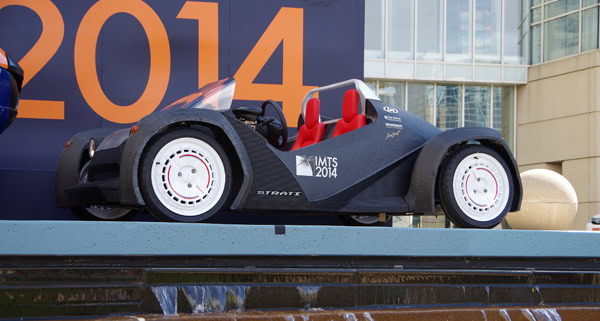
[Image above] Local Motors, with help from Cincinnati Incorporated, Oak Ridge National Laboratory, and AMT – The Association for Manufacturing Technology, unveiled the world’s first 3D-printed car at September’s International Manufacturing Technology Show in Chicago. Credit: Design Driven
Growing up, it was practically impossible to think that the future I saw on TV would ever become a reality.
Granted, I grew up in the 1980s, and given the economic, political, and neon-colored climate of the time, even as a kid it was hard to imagine beyond the days of the Reagan-era recession, Iran Contra, and Day-Glo orange.
Regardless, one of my favorite futuristic television shows was the late ‘80s reboot of The Jetsons.
You know them—George Jetson, his boy Elroy, daughter Judy … Jane, his wife.
George and company lived in a high-tech world I couldn’t even begin to fathom.
(Aside—and fun fact: The future wasn’t the only bright thing about the Jetsons; the show, which celebrated its golden anniversary in 2012, was the first program to be shown in color on ABC).
Fortunately for me, many could envision that future and helped make Jetson-era technology—flat-screen TVs, nanotechnology, robots, and flying cars—a modern-day reality. (Click here for a Wired UK article that explores just how far we’ve come in making George’s reality our reality.)
If science can make a flying car a possibility, it’s no surprise that one of the most-talked about technologies of the year, maybe even decade—3D printing—could put a drivable, 3D car at our fingertips.
Local Motors, with help from Cincinnati Incorporated, Oak Ridge National Laboratory, and AMT – The Association for Manufacturing Technology, unveiled the world’s first 3D-printed car at September’s International Manufacturing Technology Show in Chicago.
Strati—which, according to a company press release, was built in three phases over the course of the six-day show—turned heads as it took a victory lap around the convention center.
“Using 3D printing, we have reimagined how cars are created using modern manufacturing techniques,” says Local Motors CEO and cofounder John B. Rogers, Jr., who, together with AMT president Doug Woods, took Strati for its spin. “The results are astounding. We have reduced the amount of car parts from 25,000 to less than 50, proving that we can take a car from designed to driven in less than six months. That is the game changer in the automotive world.”
To find a machine big enough to handle 3D printing a car, Local Motors (based in Phoenix, Ariz.) turned to ORNL, which regularly works with automakers in developing technologies that will help them meet increasingly strict efficiency guidelines.
The lab tapped Cincinnati Incorporated’s BAAAM (Big Additive Manufacturing Machine) for the project’s first phase, and Strati, created by design competition winner Michele Anoé, was printed in just 44 hours. Phase two involved a full day of milling—or subtractive manufacturing—and in the third and final phase before the week’s end, the car, consisting of just 49 parts, was assembled by a Local Motors-led team.
Though it doesn’t fly, this car is cool enough to impress the savviest of tech-savvy folks—even guys like George Jetson.
It’s also relatively low cost (as far as cars go, at least). Forbes reports that a base model of the 1,500-pound car could cost about $18,000.
But there’s no need to wait for Strati to start production: Local Motors has made the files needed to print your own mini model, showcased in the video below, available now.
https://www.youtube.com/watch?v=wm9wRooDcGg
Credit: Local Motors; YouTube
Author
Jessica McMathis
CTT Categories
- Electronics
- Energy
- Manufacturing
- Material Innovations
- Nanomaterials
- Transportation











